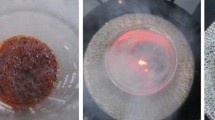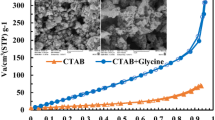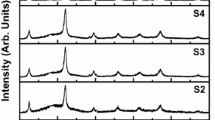Abstract
Bismuth ferrite (BiFeO3) was obtained by a combustion reaction staring from two precursors systems, namely Fe(NO3)3 · 9H2O–Bi5O(OH)9(NO3)4 · 9H2O–glycine/urea with different metal nitrate/fuel molar ratios. The precursors’ thermal behavior is dependent on the fuel nature but practically independent to the fuel content. In glycine containing systems not all Bi2O3 is included into mixed oxides during the decomposition. Its presence was identified through the existence of two endothermic phase transitions (TDTA max at 745 and 818 °C) assigned to Bi2O3 α→δ transition, and its melting. The thermal investigations performed on oxides samples reveal for all oxides, independent on the precursor system, a similar behavior. For all the oxides was identified both the Curie temperature (which decreases with the annealing cycles) and the incongruent melting point (which is with ~10 °C higher for glycine generated oxides comparative with urea ones). The structural analysis shows in the case of the oxides prepared using urea as fuel, a faster evolution toward a single phase composition with the temperature, the formation of the BiFeO3 perovskite phase being completed in the temperature range of 500–550 °C. Only some traces of Bi36Fe2O57 were identified at the detection limit. TEM analysis performed on the BiFeO3 thermally treated at 500 °C for 3 h revealed the presence of small particles with an average size of ~33 nm and polycrystalline agglomerates with an average size of ~100 nm for glycine/urea derived oxides.











Similar content being viewed by others
References
Fu YP, Lin CH, Hsu CS. Preparation of ultrafine CeO2 powders by microwave-induced combustion and precipitation. J Alloy Compd. 2005;391:110–4.
Kalai Selvan R, Augustin CO, Berchmans LJ, Saraswaithi R. Combustion synthesis of CuFe2O4. Mater Res Bull. 2003;38:41–54.
Wang SF, Gu F, Lü MK, Cheng XF, Zou WG, Zhou GJ, et al. Synthesis and photoluminescence characteristics of Dy3+ doped ZnA2O4 nanocrystals via combustion process. J Alloy Compd. 2005;394:255–8.
Sekal MMA, Patil KC. Combustion synthesis and fine particle dielectric oxide materials. J Mater Chem. 1992;2;739–44.
Minami T, Patil KC. Solution combustion synthesis of nanoscale oxides and their composites. Mater Phys Mech. 2001;4:134–47.
Wang J, Neaton JB, Zheng H, Nagarajan V, Ogale SB, Liu B, et al. Epitaxial BiFeO3 multiferroic thin film heterostructures. Science. 2003;299:1719–22.
Fiebig M, Lottermoser T, Frohlich D, Goltsev AV, Pisarev RV. Observation of coupled magnetic domains. Nature. 2002;419:818–20.
Kumar MM, Palkar VR, Srinivas K, Suryanarayana SV. Ferroelectricity in a pure BiFeO3 ceramics. Appl Phys Lett. 2000;76:2764–6.
Nakamoto K. Infrared spectra of inorganic compounds. New York: Wiley; 1978.
Penland RB, Mizushima S, Curran C, Qugliana JV. Infrared absorption spectra of some inorganic coordination complexes: X. Studies of some metal-urea complexes. J Am Chem Soc. 1957;79:1575–8.
Yan CH, Xu ZG, Xheng FX, Wang ZM, Sun LD, Liao CS, et al. Nanophase CoFe2O4 prepared by a combustion method. Solid State Commun. 1999;111:287–91.
Carp O, Patron L, Diamandescu L, Reller A. Thermal decomposition study of the coordination compound [Fe(urea)6](NO3)3. Thermochim Acta. 2002;390:169–77.
Iakovlev S, Solterbeck CH, Kuhnke M, Es-Souni M. Multiferroic BiFeO3 thin films processed via chemical solution deposition. Structural and electrical characterization. J Appl Phys. 2005;97:094901-06.
Koizumi H, Niizeki N, Ikeda T. An X-ray study on Bi2O3–Fe2O3 system. J Appl Phys. 1964;3:495–6.
Speranskaya EI, Skorikov VM, Rode EY, Serekhova VA. The phase diagram of the system bismuth oxide-ferric oxide. Izv Akad Nauk SSSR, Ser Khim. 1965;5:905–6.
Lebeugle D, Colson D, Forget A, Viret M, Bonville P, Marucco JF, et al. Room-temperature coexistence of large electric polarization and magnetic order in BiFeO3 single crystals. Phys Rev B. 2007;6:24116-8.
Habouti S, Solterbeck CH, Es-Souni M. UV assisted pyrolysis of solution deposited BiFeO3 multiferroic thin films. Effects on microstructure and functional properties. J Sol-Gel Sci Technol. 2007;242:257–63.
Singh VR, Dixit A, Garg A, Agrawal DC. Effect of heat treatment on the structure and properties of chemical solution processed multiferroic BiFeO3 thin films. Appl Phys A. 2008;90:197–202.
Palkar VR, John J, Pinto R. Observation of saturated polarization and dielectric anomaly in magnetoelectric BiFeO3 thin films. Appl Phys Lett. 2002;80:1628–30.
Wang YP, Zhou L, Zhang MF, Chen XY, Liu JM, Liu ZG. Room-temperature saturated ferroelectric polarization in BiFeO3 ceramics synthetized by a rapid liquid phase. Appl Phys Lett. 2004;84:1731–3.
Paraschiv C, Jurcă B, Ianculescu A, Carp O. Synthesis of nanosized bismuth ferrite (BiFeO3) by a combustion method starting from Fe(NO3)3·9H2O–Bi(NO3)3·9H2O–glycine or urea systems. J Therm Anal Calorim. 2008;94:411–6.
Author information
Authors and Affiliations
Corresponding author
Rights and permissions
About this article
Cite this article
Jurca, B., Paraschiv, C., Ianculescu, A. et al. Thermal behaviour of the system Fe(NO3)3 · 9H2O–Bi5O(OH)9(NO3)4 · 9H2O–glycine/urea and of their generated oxides (BiFeO3). J Therm Anal Calorim 97, 91–98 (2009). https://doi.org/10.1007/s10973-009-0080-x
Published:
Issue Date:
DOI: https://doi.org/10.1007/s10973-009-0080-x




